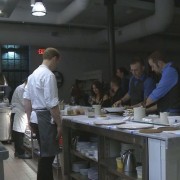Loud restaurants becoming new dining trend
MINNEAPOLIS – Have you been to a restaurant lately that was so loud you couldn’t have a conversation? If it made you feel old, we’ve got some good news for you. That energetic environment is actually the new trend in dining out.
Does that mean you’re never going to be able to enjoy a quiet meal? Not at all.
“The further you get from the energy sources – the bar over there, the cooking over there – you have that zone for people who want to go out for a nice quiet evening,” says David Shea with Shea Design.
David is an expert in designing restaurants and is the man behind many of the high-profile eateries in town. He says research shows people want to eat in a place that feels energized but most restaurants are now designed with all kinds of customers in mind. He took us through two of his latest projects to show us exactly what he means. We toured Marin downtown and Spoon and Stable in the North Loop.
Marin has three very distinct zones. The dining area of the restaurant uses a lot of upholstery, banquets and curtains to absorb sound. There is even one whole wall covered in leather to help dampen sound. They actually found it to be too quiet and added a pizza oven to give the upstairs a little white noise. The bar area, however, has plenty of wood to give sound just a little more bounce and the library bar in the cellar has an even different vibe.
“The music system is different downstairs than it is upstairs and the bar is smaller but it’s some of the original stone from the building from the late 1800’s and that’s loud; that’s hard,” he says.
Being a chef these days means you have to think about more than just the menu.
“It’s like theater, everything has to be right – lights, music, food, the whole package,” says Chef Mike Rakun at Marin.
Noise was definitely a concern for Chef Gavin Kaysen when he, just months ago, launched Spoon and Stable.
“When we were building the restaurant I would wake up in cold sweats thinking to myself, ‘It’s going to be too loud, it’s going to be too loud,'” says Chef Kaysen.
His concerns were valid, because like the name infers, the space was an old horse stable.
“This has got more exposed brick, high ceilings, sky lights, overhead doors to the street. It’s got a very youthful vibe just like most of the North Loop has, ” says Shea.
So, how do you take that high-energy, smaller space and make it so people can hear and the chef can sleep at night? David says it’s all about creating zones. A more vibrant bar area, plenty of energy in the kitchen and the more subdued dining area sandwiched in the center.
“With the almost 35-foot-high ceilings in here, it does break up the sound. If you had a low ceiling, you’d have to put more sound absorbing material in. But if you look in here, very, very little sound absorbing materials,” David Shea explains.
That’s all great information, but let’s be honest, some loud restaurants have not mastered the art of sound. So, how loud is too loud? We went to the experts at Starkey Hearing Technologies to find out.
“It really all boils down to the intensity of the sound as it’s measured in decibels and the duration, the continuous duration of the exposure,” says David Fabry, Ph.D.
What Dr. Fabry says is the magic number appears to be 100 decibels.
“If you’re going to a restaurant where they have a live band or live entertainment, or they’re trying to create that atmosphere that is lively, 100 decibels for an hour’s duration of dinner places you at risk for permanent loss,” he says.
To give you some perspective on what 100 decibels sounds like, Starkey says it compares to the sound of a lawnmower, chainsaw or other power tools. But how do you know while sitting there if the noise level is dangerous? We used a Starkey decibel meter to test it.
We went back to Marin and Spoon and Stable on a Friday and Saturday night. At Marin in the dining area our meter registered roughly 73 decibels, peaking at 79. The bar at Marin was only a bit louder registering at 76.
At Spoon and Stable we took readings in the bar, dining area and at the counter next to the kitchen. It was fairly consistent throughout. The decibel meter gave us readings around 80 in all three locations. There were peaks of sound near 90 but never did it go over that threshold for any length of time. All acceptable levels, but why can’t you hear your dinner conversation? This is the part you might not like.
“We’d like to think that as you get increased hearing loss you could also tolerate louder sounds, but the reality is your tolerance for loud sounds stays roughly the same,” says Fabry.
In other words, the older we get, the louder we need people to speak to overcome that background noise. Restaurant owners say they know your ability to have a conversation is just as important as what is on the menu.
“The food is an important aspect to the dining experience, but really it’s just part of the experience,” says Chef Kaysen.
Curious about how loud it is? We tried out a few apps that measure decibels.
Starkey has it’s own app called SoundCheck. It’s not only free but worked the best out of the three we tried. It’s easy to use and has a clean, clear read-out.
Decibel 10th is also free and works just fine with some occasional pop-up ads. It has both a graph and meter display and is also easy to use.
We also tried Decibel Meter Pro, which cost us $1.99. This one is not recommended. Not only is it hard to read, the meter jumps around all over the place, and it consistently was up to 10 decibels off of what they other apps and the actual decibel meter were reading.
Starkey also has some tips for when you’re dining out to have the best possible experience. Try to sit at the farthest point from where the main noise source is and put the person you’re trying to hear in front of you with the noise source behind you. Your ears, because of their shape, act as their own “hearing aid,” if you will, blocking the sound from behind and amplifying the sounds in front.
They also suggest sitting near softer surfaces like curtains and upholstered seats. It will help dampen all that background noise.
http://www.kare11.com/story/news/local/2015/02/19/loud-restaurants/23651019/




